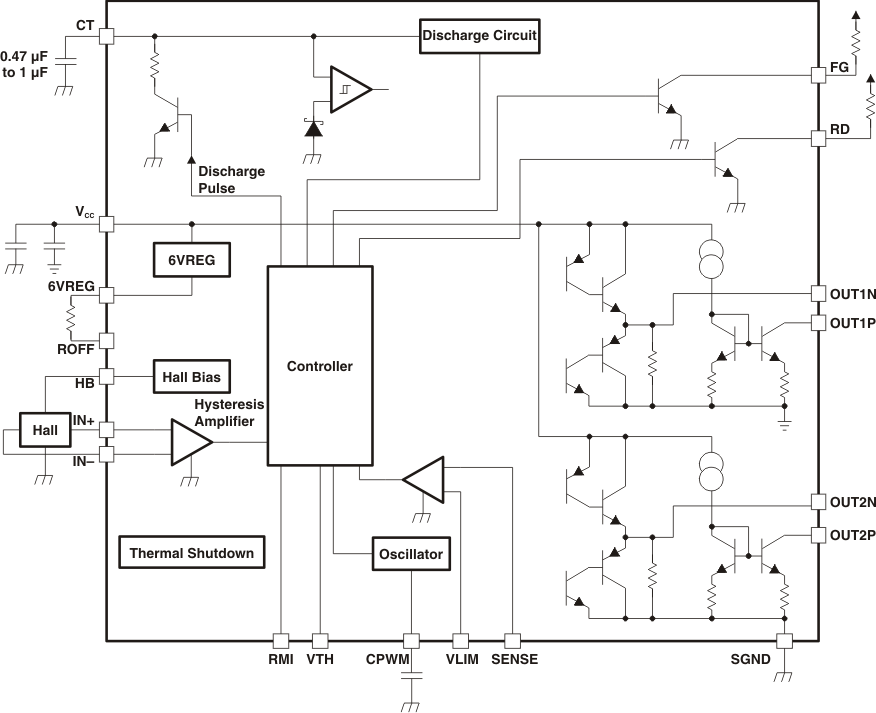SLDS151A May 2009 – June 2015 TMP814
PRODUCTION DATA.
- 1 Features
- 2 Applications
- 3 Description
- 4 Revision History
- 5 Pin Configuration and Functions
- 6 Specifications
- 7 Detailed Description
- 8 Application and Implementation
- 9 Power Supply Recommendations
- 10Layout
- 11Device and Documentation Support
- 12Mechanical, Packaging, and Orderable Information
Package Options
Mechanical Data (Package|Pins)
- PW|20
Thermal pad, mechanical data (Package|Pins)
- PW|20
Orderable Information
7 Detailed Description
7.1 Overview
The TMP814 device is a single phase bipolar predriver which uses the hall sensor & speed control inputs for driving the single phase motor connected through H Bridge. The predriver outputs are designed for driving top side P-type devices and bottom side N-channel FETs in the bridge. Multiple protections like overcurrent, soft-start, speed control, lock detect, speed feedback and minimum speed are incorporated in the device. The circuit can be used for driving the 24-V or 48-V system using a VOVER pin, which protects the VCC to be less than the limit of 18 V.
7.2 Functional Block Diagram

7.3 Feature Description
7.3.1 Speed Control
The speed control functionality is obtained by VTH pin of the device. For pulsed inputs user can supply a 20 kHz-100 kHz frequency input (20 kHz to 50 kHz recommended on the pin with a current limiting resistor in between. If not used, this pin needs to be connected to ground for full speed.
7.3.2 Constant Voltage Bias
Constant Voltage Bias is provided through VOVER Pin. This must be used for applications of 24 V and 48 V. See Figure 3. This drive limits the VCC under permissible values even when Vm > 18 V. Leave this pin open when not in use.
7.3.3 Soft-Start
Soft-Start Time can be using the ROFF pin. Connect 6 to 6VREG is not used.
7.3.4 Lock Detection
When the rotor is locked by external means or load conditions, The lock detection feature helps to protect the circuit by not allowing the current to rise beyond control. A hiccup mechanism is also provided. The lock detection is enabled by a connection to the lock detection capacitor. When the pin voltage rises to 1.2 V, the constant current charge and discharge circuits cause the drive to and enables it back when voltage reaches 0. If lock detection feature is not desired in the application, then this pin must be connected to ground.
7.3.5 Current Limit
Current limit resistor is connected in a return path of H Bridge connection. This input is connected to the SENSE pin where the Current is limited when the voltage across this resistor crosses the voltage at VLIM Pin. If not used, this pin needs to be connected to ground.
7.3.6 Minimum Speed Setting
Minimum speed setting feature is used with the RMI pin in the device. Connect to 6VREG with a pullup resistor if not used.
7.3.7 Speed Output
The speed of the motor while running can be observed at the FG pin which is an open collector output and needs to be pulled high for using it.
7.3.8 Drive Frequency Selection
The P channel switches in the device are switched with higher frequency whose duty cycle is decided by the speed control input. The frequency of the operation can be decided by the capacitor connected at the CPWM pin. As this is used also for the current limiting canceling signal, be sure to connect the capacitor even when speed control is not used.
7.4 Device Functional Modes
Table 1. Truth Table(1)
| IN– | IN+ | CT | OUT1P | OUT1N | OUT2P | OUT2N | FG | RD | MODE |
|---|---|---|---|---|---|---|---|---|---|
| H | L | L | L | – | – | H | L | L | OUT1 → 2 drive |
| L | H | – | H | L | – | OFF | OUT2 → 1 drive | ||
| H | L | H | OFF | – | – | H | L | OFF | Lock protection |
| L | H | – | H | OFF | – | OFF |
| VTH | CPWM | IN– | IN+ | OUT1P | OUT1N | OUT2P | OUT2N | MODE |
|---|---|---|---|---|---|---|---|---|
| L | H | H | L | L | – | – | H | OUT1 → 2 Drive |
| L | H | – | H | L | – | OUT2 → 1 Drive | ||
| H | L | H | L | OFF | – | – | H | During rotation, regeneration in lower TR |
| L | H | – | H | OFF | – |